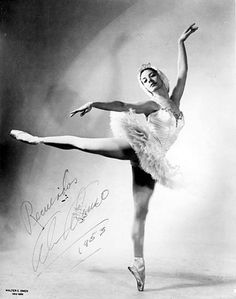 Alicia Alonso (born Alicia Ernestina de la Caridad Martínez Hoya; 21 December 1921) is a Cuban prima ballerina assoluta and choreographer.
Alicia Alonso (born Alicia Ernestina de la Caridad Martínez Hoya; 21 December 1921) is a Cuban prima ballerina assoluta and choreographer.
Alonso was born in Havana, one of two daughters of an army officer and his wife. The family was financially comfortable and lived in a fashionable section of the then-vibrant capital. Alonso revealed at a very early age an affinity for music and dance – her mother could occupy her happily for long periods with just a phonograph, a scarf, and some records. She started dancing at the age of seven and at the age of eight, she studied ballet at Sociedad Pro-Arte Musical in Havana with Sophie Fedorova. A year later she performed publicly for the first time in Tchaikovsky’s Sleeping Beauty. She originally danced in Cuba under the name of Alicia Martínez.
Rapid progress in her lessons came to an abrupt halt in 1937, when the 16-year-old fell in love with a fellow ballet student, Fernando Alonso, whom she married. After her marriage, she changed her surname to Alonso. The new couple moved to New York City, hoping to begin their professional careers.
From the age of nineteen, Alonso was afflicted with an eye defect and was partially blind. Her partners always had to be in the exact place she expected them to be, and she used lights in different parts of the stage to guide them.
Alonso was injured when a hurricane shattered a door in her home, spraying glass splinters onto her head and face. Amazingly, her eyes were not injured. When her doctor saw this, he cleared Alonso to begin dancing, figuring that if she could survive an explosion of glass, dancing would do no harm.
Alonso’s desire to develop ballet in Cuba led her to return to Havana in 1948 to found her own company, the Alicia Alonso Ballet Company, which she maintained with little financial support, this company eventually became Ballet Nacional de Cuba. Fernando was general director of the company, which was at that time composed mainly of Ballet Theater dancers temporarily out of work due to a reorganization in the New York company.
Fernando’s brother Alberto, a choreographer, served as artistic director for the company.
Her company became the Ballet Nacional de Cuba in 1955.
She is most famous for her portrayals of Giselle and the ballet version of Carmen.
Alonso worked with the Ballet Russe until 1959, during which time she performed in a 10-week tour of the Soviet Union, dancing in Giselle, the Leningrad Opera Ballet’s Path of Thunder, and other pieces. Her performances earned her the coveted Dance Magazine Award in 1958.
Due to Alonso’s affiliation with the new regime in Havana, U.S. audiences largely turned their backs on the prima ballerina. In addition, as with the Russian ballet companies, exposure to western audiences would promote defectors who would cause huge embarrassment to the Soviet Union, so the Cuban government from the 1960s through the 1980s did not allow Cubans to performm in the U.S. and monitored anyone with contacts outside Cuba via phone cables and letters. Alonso’s company, however, continued to build its powers and achievements in both Eastern and Western Europe.
As director and leading dancer of the Ballet Nacional de Cuba, she has taught many now notable dancers in Cuba and beyond. Some former students are now dancing at the American Ballet Theatre, the Boston Ballet, the San Francisco Ballet, the Washington Ballet, the Cincinnati Ballet and the Royal Ballet, among others. In June 2002 she was designated UNESCO Goodwill Ambassador for her outstanding contribution to the development, preservation and popularisation of classical dance and for her devotion to the art-form.
Agencies/Various/InternetPhotos/youtube/TheCubanHistory.com
The Cuban History, Hollywood.
Arnoldo Varona, Editor



 Alicia Alonso, prima ballerina, choreographer. (Havana)
Alicia Alonso, prima ballerina, choreographer. (Havana)
